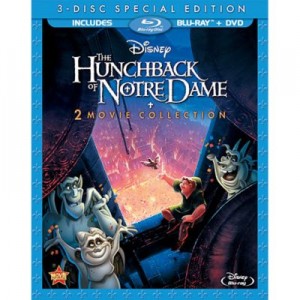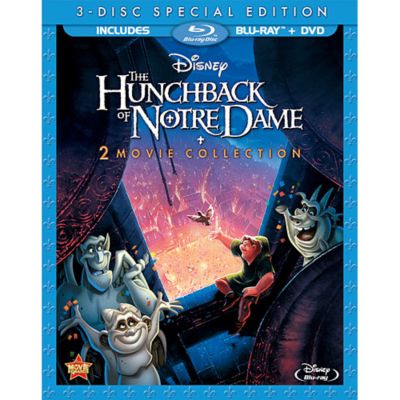
Based on Victor Hugo’s 1831 novel of the same name, The Hunchback of Notre Dame was released on June 21, 1996. The film, which is 91 minutes in length, was the 34th full-length animated feature in Disney history.
Plot Summary
As was well put by the film’s gypsy narrator, Clopin, The Hunchback of Notre Dame is a story of “a man and a monster.” Indeed, the tale features two conflicting protagonists.
On one hand, there’s Quasimodo, the title character, who serves as the bell ringer at the Notre Dame Cathedral in Paris. A gypsy orphan, he possesses a warm heart in spite of his less-than-appealing looks.
Then, there’s Judge Claude Frollo, a government official who has raised Quasimodo for the previous 20 years after, unbeknownst to Quasimodo, killing the boy’s mother. Frollo is a man of questionable morals. He seeks to eliminate sin from the world by ruthlessly purging the gypsy population of Paris.
So, “who is the monster, and who is the man?” The answer lies deeper than what’s easily discernable at the surface.
Quasimodo
Quasimodo is a kind young man who is almost literally trapped in a terrible situation. Frollo keeps him cooped in the Notre Dame bell tower, and although said tower features a wonderful view of Paris, Quasimodo wants to get out and explore the world.
If the tower confinement wasn’t bad enough for our protagonist, the judge brainwashes the boy, repeatedly telling him that the world is cruel and that he’s ugly; the name Quasimodo, in fact, means “half-formed” according to Clopin.
The brainwashing is also a major reason as to why Quasimodo is trapped. The boy could probably escape if he wanted to, but he still believes that Frollo is a good man, and he doesn’t want to disappoint him. Sometimes psychology is a stronger force than physical chains.
Despite having been raised by a terrible man, Quasimodo’s relationship with Esmeralda, a gypsy girl who’s wanted by Frollo, shows him to be a good person. He appreciates Esmeralda because she is the first person that he can remember being kind to him—the gargoyles don’t count because they’re stone creations, not people. Thus, while he is initially heartbroken that Esmeralda loves Captain Phoebus and not him, Quasimodo nonetheless does all he can to help the girl.
Comic Relief
Though The Hunchback of Notre Dame is a dark and dramatic film at its core, comedic elements are inserted throughout.
The most obvious humor comes through the three gargoyles: Hugo, Victor, and Laverne. This trio offers advice to Quasimodo in funny ways. For example, they tell the boy to attend the Festival of Fools because, among other reasons, he can play “dunk the monk” and go “bobbing for snails.”
Laverne is my favorite gargoyle because she’s both crabby and amusing. In a period of time faster than the launch of Walt Disney World’s Rock ‘n’ Roller Coaster (zero to 60 miles-per-hour in 2.8 seconds for those of you playing along at home), Laverne can switch from shooing a flock of birds to consoling Quasimodo.
The gargoyles aren’t the film’s only source of laughs. For the most part, the Festival of Fools scene is visually amusing with many crazy masks and props. Also, several minor characters, including an unlucky old man and Phoebus’ horse Achilles, are inserted as gags, though I don’t think Frollo’s soldiers would concur with the latter choice.
Music
The music in The Hunchback of Notre Dame is solid and well-spaced throughout the film’s duration. The songs range from lovely numbers to funny tunes.
Immediately at the movie’s commencement, “The Bells of Notre Dame” is performed by Clopin. This dramatic song sets the stage for the ensuing plot.
Sung by Quasimodo, “Out There” reveals the hunchback’s burning desire to experience life outside the bell tower for once. I found the rendition of this song in the film proper to be exhilarating; the sights of Quasimodo using the cathedral as a jungle gym and sliding down a waterfall, respectively, gave me an adrenaline rush! Also, although we’re dangling at high altitudes, be sure to look down during this segment—Belle from Beauty and the Beast (1991) makes a cameo in the street.
“God Help the Outcasts” is performed by Esmeralda while she’s trapped in the church. With beautiful lyrics and great imagery of Notre Dame, I actually shed tears while beholding this scene.
Though “Heaven’s Light” is also a heartwarming song, I found the corresponding visuals of the gargoyles drawing funny pictures to be out of place. The doodles may be amusing, but I thought they took away from the beauty of the song.
Frollo’s “”Hellfire” is arguably the darkest number in Disney history. Detailing the judge’s desire to kill Esmeralda, the lyrics and the visuals are both chilling. The song is catchy but not very child friendly.
At the opposite end of the spectrum from “Hellfire,” “Topsy Turvy” and “A Guy Like You” are included for comic relief. “Topsy Turvy” uses silly rhymes to describe the Festival of Fools, while “A Guy Like You” depicts Quasimodo’s positive attributes amidst a burning Paris.
In the Parks
Since the closing of Walt Disney World’s “The Hunchback of Notre Dame: A Musical Adventure” stage show in 2002, The Hunchback of Notre Dame hasn’t held a major place in Disney’s parks. Still, characters from the film, most notably Quasimodo and Frollo, make occasional appearances at Walt Disney World.
Overall
The Hunchback of Notre Dame is unquestionably one of Disney’s darkest animated features, and the suitability of its “G” rating was questioned at the time of the film’s release. Mature themes aside, this film has always been my favorite, not necessarily because it’s Disney’s best movie, but because of nostalgia.
To digress a bit, I was six years old when The Hunchback of Notre Dame was released, and I have great memories of it. Aside from seeing and enjoying the film at the theatre—I think the mature aspects went over my head—my only collection arose from this movie. For about three months in mid-1996, Burger King regularly released new Hunchback character figurines with its Kids Club Meals. I got my mom to take me to the restaurant at least once each week so that I could collect the toys, and if we were given a duplicate, she would ask the cashier if the next one in line was available. Hamburgers and chicken nuggets were definitely secondary factors in these fast food adventures!
I eventually succeeded in my figurine quest, though they have, unfortunately, long since been taken to the town dump. Ah, the power of childhood memories!
What do you think of The Hunchback of Notre Dame? Let me know in a comment!
Sponsored Ad: Would you like to help support The Mouse For Less website in continuing their mission of being THE Disney vacation planning resource? You can do so by purchasing The Hunchback of Notre Dame from our affiliate link through Amazon.


great review! Makes me want to go watch the movie again.
Thanks, and go for it 😀
Great review, Andrew! Hunchback is one of my all-time Disney Favorites, and I think has been really under-rated. The music is just so good
Did you get a chance to watch the Alan Menken/Richard Sherman concert from D23 expo this past summer? The whole thing was awesome, but Alan Menken did a Hunchback medley that was fantastic.
Hey Brent. Sorry for the delayed response; just saw your comment now!
Didn’t see that concert, but will look it up. Thanks for the information.